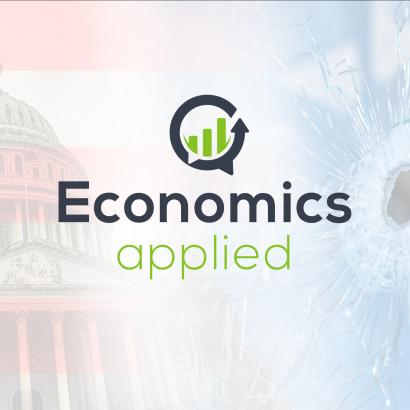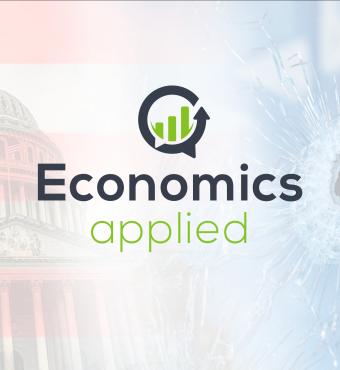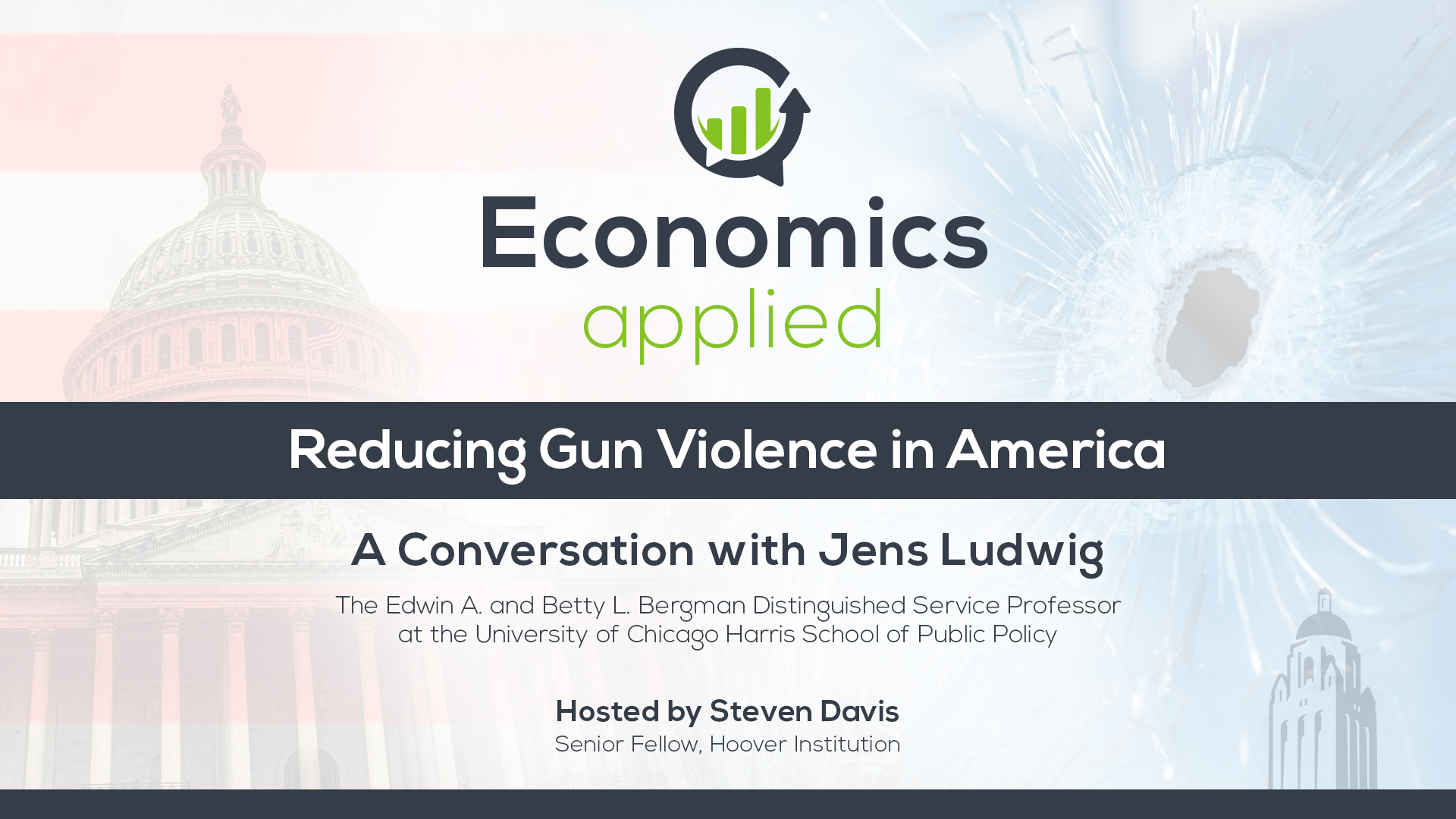- Economics
- Politics, Institutions, and Public Opinion
- State & Local
- Answering Challenges to Advanced Economies
Steven Davis chats again with Jens Ludwig about his new book on gun deaths in America. The conversation focuses on low-cost policy solutions that can reduce gun deaths without remaking American society. The solutions include pocket parks, predictive policing, and programs that help people think about behavior in stressful situations.
Recorded on April 23, 2025.
WATCH THE VIDEO
>> Steven Davis: Welcome to Economics Applied. I'm Steven Davis, host of the show. Today we're gonna continue my conversation with Jens Ludwig. He's a professor at the University of Chicago where he directs the university's crime lab. So let's get into solutions. And I wanna go through various solutions that come out of your preferred way of thinking.
Tell us what they are and maybe say a word about what we know about the extent to which they work, or they just seem like good ideas but not yet fully tested on the ground.
>> Jens Ludwig: Yeah, let me maybe start off with a sort of a higher level framing point.
Which is, I would encourage your listeners or viewers to just reflect for themselves for a moment on what they think their own favorite solution is to the crime and gun violence problem in America. So depending on people's politics and their priors, they'll think more prisons, more cops, more early childhood education, more K-12 spending, more drug treatment, more mental health treatment.
I'm sure there are some other things that I haven't thought of, but you get the idea. People are walking around-
>> Steven Davis: Family counselling.
>> Jens Ludwig: Yeah, people are walking around with whatever this wish list is that they have, right? And I think realistically, if you look at the next four years, you should just throw those mental wish lists out the window, right?
If you look at the city of Chicago, let me just use the city of Chicago as an example, right? Our budget, we're staring down the face of a $1 billion budget deficit for next year that the city, as far as I can tell, has no idea how they're gonna close.
And you might think maybe they can go to Springfield, Illinois, to the state capitol and ask the state for help. But the state is facing down something like, as I understand it, a $5 billion budget deficit. And you might think, well, maybe the city of Chicago can go to the federal government for help.
And I think, if anything, it's gonna go in the other direction. The administration is threatening-
>> Steven Davis: I take it the larger point is we need cost effective ways to reduce gun deaths.
>> Jens Ludwig: No, not cost effective, zero cost ways.
>> Steven Davis: Okay, well.
>> Jens Ludwig: Let me make this really-
>> Steven Davis: You mean zero monetary cost. There's always some cost, you're an economist, so-
>> Jens Ludwig: Yeah, fair.
>> Steven Davis: Somebody's gotta put in time and effort.
>> Jens Ludwig: Well, let me tell you, I'm gonna argue that there are close to zero costs even in the way an economist would think about this.
>> Steven Davis: Okay, okay.
>> Jens Ludwig: Let me explain what I mean. So this is just to say, right, one sort of conversation that we could be having is, how does this behavioral economics set of solutions compare to your favorite solution? I don't think that's the right conversation cuz I don't think what other people have been talking about is even an option in the current fiscal environment.
And Chicago's not alone in that, right? Go around the country and look at the financial situation that cities are in. It would be very, very easy to think, boy, we are just screwed. Okay, so I think here's one thing that we can do for starters. Let me go back to the poker player analogy and poker players going on tilt.
When you talk to poker players and you ask them, how did you get better at playing poker? You might think it's all about, I learned a new trick for counting cards or whatever. But a lot of what good poker players say is, one of the easiest and first ways that they got better at playing poker is they learn to recognize this tendency to go on tilt and avoid it.
And that already is a little bit of a light bulb moment because it tells you that that is something that people can learn. They can learn something about their own thinking. Poker players do it. How do poker players do it? Through trial and error and feedback. Feedback is, I go home at the end of the night and I lost a ton of money at the poker table, and I'm looking at what went wrong.
I was pissed off for two thirds of the night. Maybe that wasn't so helpful kind of thing. For a 16-year-old kid growing up in Greater Grand Crossing, trial and error is a hugely difficult and potentially very costly way to learn. So-
>> Steven Davis: Because you might get shot.
>> Jens Ludwig: You might get shot.
>> Steven Davis: Or arrested and incarcerated for a long period.
>> Jens Ludwig: Yeah, and so we've been working with a bunch of nonprofits and government agencies to study these programs that basically teach young people on the south and west sides of Chicago who are living in the most unforgiving places how to recognize when they go on tilt and how to avoid that.
We can get in the details of what they look like, but let me just say one other thing. Pragmatically, on the policy front for this is, a few years ago, we were talking to the administrator of the Cook County Juvenile Temporary Detention Center. This guy, Earl Dunlap, who was running the place because a federal judge had taken it over, he thought it was really terrible and whatever.
And so Earl was like, I have no money to do anything, but the kids would go to school, they'd go to Nancy B Jefferson, the Chicago public school in the morning. And then they basically spend the afternoon in the common room watching TV with a guard standing against the wall watching them watch TV.
And Earl was like, I don't have any money to do anything. But I think we can probably figure out how to do something that's more developmentally productive for the afternoon than watching six hours of TV. And so we worked with Earl to basically train the detention staff to have the kids go through one of these programs that leads them to recognize when they go on tilt.
And Earl was like, this is not going to be the greatest social program in the whole world, right? But it doesn't cost me anything cuz I've got the guard, I've got the kids, I've got the facility. The marginal cost was like a week of training and the cost of mimeographing the books.
And we structured that like a randomized trial and we see that recidivism goes down by 20%.
>> Steven Davis: Yeah, okay, but there's still cost here. There may be no monetary cost, but there's gotta be people of goodwill, I'm putting you in that category now, who are willing to help these folks out.
I think I'm quite sympathetic, not just to the recognizing when you go on tilt and responding to that in a productive way, I've seen that. I spent a few years going to school in a pretty violent neighborhood, so I've seen the phenomenon you describe. The other thing which is similar in some respects but not quite the same is to put young people through different hypothetical situations and help them think through how they would respond.
So this is a different type of feedback, but it's like, okay, if you do get in this situation, let's think about it in advance. And hopefully, then they'll take a more system 2-like response to the situation than a system 1 response.
>> Jens Ludwig: Yeah, all of these programs at heart are giving kids a chance.
The best versions of these programs are putting kids in scenarios where they can trial and error and feedback in sort of very low stakes situations so that they're more prepared out on the street.
>> Steven Davis: Yeah, I'm a fan of that kinda thing, but I don't see those as low cost.
They may be lower cost than some of the things we do now, but it takes skill to execute that. And you either need to have volunteers who Who are willing to do it or you got to pay people.
>> Jens Ludwig: Yeah, well here's what I mean by low cost, which is I think a lot of the institutions that we have built for young people have low opportunity cost time built into them, right?
And that's why I tell the story about the kids watching six hours of TV. Like the cost, set aside the training cost for the moment. The opportunity cost literally is the guard standing against the wall watching the kids versus the guard standing in front of the room having them do activities.
That's as close to zero cost as we could ever get.
>> Steven Davis: Because you're saying, look, we've already allocated a lot of resources to do something with these kids. We're not using those resources very well. We can just reorient what's happening in those situations like the kids, instead of them watching TV for six hours, they're engaged in these role playing scenario, thinking type approach, to help them navigate the challenges they will actually face in their lives later on.
So that's what you mean by low or zero.
>> Jens Ludwig: Yeah, exactly and let me just give you one other example of low opportunity cost time with an institution that works with tons of young people. So I went to Lenape High School in Medford, New Jersey and the state of New Jersey, in its wisdom, if I'm remembering correctly, this was back in the 1890s.
So it was a long time ago. I might be misremembering a little bit. I believe that I was required by the state of New Jersey to take four years of health education. And here's what I recalled the health education curriculum being. It was eat more broccoli, sleep eight hours a night, don't drink alcohol because it's bad for you, and here's where babies come from.
>> Steven Davis: It took you four years to get all that?
>> Jens Ludwig: It took me four years to get all of that. That is very low. It's basically telling kids things that they are either for sure gonna ignore or they already know.
>> Steven Davis: That's to my point about skill. If you're a 35 year old social worker and you come into a bunch of a class with a bunch of 14 and 15 year olds, it takes some skill to get their attention and keep them engaged.
>> Jens Ludwig: Yeah, but I mean, let me go back to the juvenile detention. Like the guards were not hired for their ability to deliver social programs to kids.
>> Steven Davis: Understood, understood.
>> Jens Ludwig: And this is not some boutique hot house ideal pilot program. Earl Dunlop took the guards who were there, trained them and it was like, whatever's gonna happen is gonna happen.
>> Steven Davis: Was effective. This is an RCT.
>> Jens Ludwig: This was an RCT.
>> Steven Davis: Okay, that's impressive and you're making me revise my assessment of it.
>> Jens Ludwig: And I don't believe that health teachers. If you look at the leading causes of death to adolescents in the United States, it's homicide, especially in low income minority communities, it's suicide, it's drug overdoses and it's motor vehicle accidents.
It's basically deaths of decision making.
>> Steven Davis: These are all things that are potentially quite responsive to the kind of program you're describing.
>> Jens Ludwig: Exactly, exactly, exactly. And so why aren't we. And these programs only take something like 15 to 20 hours. If you've got kids for four years in health education, why are we not carving out a month of classes over those four years to do this?
>> Steven Davis: What was the old. But there have been failed campaigns along these lines too. I'm trying to remember what the slogan was. Just say no. These things have to be done with some in a way that resonates with the audience.
>> Jens Ludwig: For sure.
>> Steven Davis: Point I'm trying to make.
>> Jens Ludwig: Yeah, totally, totally, totally agree. There's always a bad way to do everything, I totally agree.
>> Steven Davis: Okay, so this is one class of interventions and I'm gonna summarize it. It's a combination of two things and tell me if I've got it wrong. To young people, recognizing when you're going on tilt and how you should respond.
And second, thinking through in advance some situations that might relate to situations you actually will face in your everyday life that could be fraught with danger. But thinking in advance, what would be a better way to respond?
>> Jens Ludwig: Yeah, I think that it's the one and the same.
>> Steven Davis: Those are the same.
>> Jens Ludwig: It's putting kids in scenarios and having them see themselves go on tilt and then say, okay, now, you recognize that you were just in this scenario and you went on tilt. Now let's step back and think about alternative ways that you. What was the trigger for you to go on tilt?
Now when you're in the real world, what do you do, that sort of thing.
>> Steven Davis: So I think I agree with you. This is a potentially very productive approach. It can be done poorly or well. Okay, so that's one. So give me another one.
>> Jens Ludwig: Yeah, and I just want to underscore too, we have the capacity to deliver that at huge scale.
We spend $800 billion on public schools and another $100 billion on detention facilities, which by definition are touching the highest risk people we could infuse.
>> Steven Davis: Look, I agree with that, but I just wanna inject a note of not skepticism, but caution. There are a lot of good ideas that when the government tries to scale up, don't work.
So I'll give you an example in a different context. We can all imagine situations with somebody's lost their job and with some useful retraining could gain new skills, hopefully skills that complement the ones they already had, that would then make them an attractive candidate for re employment. So I accept that.
On the other hand I think it's fair to say of the many, many federally supported job retraining programs, most of them haven't worked very well. So, I did this as a standard caution. You're well aware of this. Scaling up interventions that work very well in limited settings is often a lot more challenging than it appears.
>> Jens Ludwig: Yeah, I totally agree with that. You know the economics research as well as I do on the returns to schooling. We have this $800 billion a year public school system that generates whatever the annual rate of return is for an extra year of school. Maybe a better school system could generate a higher rate of return, but we're doing something right at large scale.
I totally get the caution, but why aren't we trying to infuse this stuff there? Okay, great. So the next one. I think the next thing that we could be doing with almost no additional resources is to do a much better job of positioning the eyes on the street that cities are currently employing in the times and places when gun violence is most likely to happen, right?
Because I think what is underappreciated in practice, every criminologist knows this, but when you look at what cities do in practice, I think it. Practice does not look like it is taking this idea very seriously. There is an enormous amount of predictability in the time and place when gun violence will happen.
Let me just give you one example. There is a liquor store on the south side of Chicago at 57th in State street that is open until midnight. And almost every other liquor store on the south side is open only until 9 or 10 PM. Why is that liquor store opened until midnight?
My uninformed hypothesis is maybe there's an Alder person with a speedboat that is connected to this somehow, I don't know. I don't know, but nonetheless it is. So what happens on the south side of Chicago up until 9 or 10 is that everybody goes to their local liquor store to buy their booze.
They're going with the people that they grew up with, they know, they like. And around 9 or 10 o'clock, what happens? It's sort of the witching hour. Everyone from the south side of Chicago, I've got a beef with you over in this other neighborhood cuz your girlfriend said this thing to my sister and the whatever and we're pissed off and whatever.
And at 10 o' clock we all converge to 57th states-
>> Steven Davis: And we may have been drinking for a couple hours already.
>> Jens Ludwig: And we may-
>> Steven Davis: We ran out that's why-
>> Jens Ludwig: We may have been, drinking for a couple hours up until 10 and ran out. So we show up at 57th and state, liquored up with a bunch of grudges against other people from all over the south side.
And guess what the data shows for what happens between 10 PM and midnight at 57th and straight, a bunch of terrible things. And I think partly for political reasons, cities have become a little ambivalent about using data to target where they put police officers and where they put violence interrupters.
>> Steven Davis: Such an obvious thing to do.
>> Jens Ludwig: I think it is a concern that the data will lead to rising disparities and where police spend their time. I think in practice that's not what the data say actually happened. The Los Angeles Police Department did a randomized control trial of what happens when you use data to target predictive policing to hotspots.
And there's no change in the racial composition of who's arrested when you do that. But I've talked to the UCLA professor who helped build the targeting tool, and he tells me he was shocked.
>> Steven Davis: This guy generated a huge controversy with this algorithmic approach to policing.
>> Jens Ludwig: Yeah, but essentially what it is doing is finding the liquor stores from 10 to 12, that's concretely what's going on.
And you can see very concretely why that would be so useful. And you can see in the data the overwhelming majority of people who would benefit, whose lives would be saved, would be in minority communities where the gun violence problem is disproportionately concentrated. And so I say that is something that cities need to take more seriously because in the grand scheme of things, using data to build statistical models to figure out how to deploy your people, it is not free.
But it is truly a rounding error compared to what we're spending on police and violence interrupters and all this other stuff.
>> Steven Davis: Yeah, this one is really a striking example of how the political process can impede what seem like common sense solutions or improvements on how we manage the threat of gun violence.
And some of this does happen more less formally, I think. I mean, Chicago is a place where the summer evenings can often be hot and uncomfortable. And it's well known that Friday and Saturday and Sunday evenings maybe as well in the summertime, especially if it's hot, unpleasant gun violence goes up often among young people in lower income neighborhoods.
So the police know that, I mean, even I know it just casually reading the newspaper. So I presume they have more officers on the street in the evening on hot summer nights than they would otherwise. So this happens to some extent anyway.
>> Jens Ludwig: Yeah, it does happen to some extent and both in terms of staffing levels the staffing levels go up when the gun violence surges, you're right.
It's still imperfect, the shifts end too early relative to when gun violence extends later in the evening than the surgeon staffing. There's some things you can fix. But it's also the case that the Los Angeles Police Department experiment that I mentioned, the treatment condition there, the intervention condition was use a statistical model to decide where to deploy people.
The control condition was not nothing, the control condition was extra cops allocated through human intuition. And when you look at the map.
>> Steven Davis: Okay, so you're comparing to this, at least in this particular case, it's being compared to the informal allocation of resources.
>> Jens Ludwig: Exactly.
>> Steven Davis: That has already happened.
>> Jens Ludwig: Exactly, and relative to that alternative or that counterfactual, the statistical model deployment winds up doing something like doubling the amount of crime prevention you get from an existing level of police resources. So it's not small, right?
>> Steven Davis: That's a huge effect from your right for a city of the scale of Los Angeles, this is really a pittance.
The cost of developing this model if the data are already in hand. So help me understand better what is the political resistance to this. Remind me cuz I've sort of forgotten why was this so politically controversial?
>> Jens Ludwig: It is the intersection of a couple things that lots of people don't like.
So it involves the police for starters, even though-
>> Steven Davis: It involves the police.
>> Jens Ludwig: Involves the police for starters. And even though in principle you could also target violence interrupters, it's not just targeting police. So we built a violence reduction dashboard for the city of Chicago, it's on city hall's website that nonprofits all over the city.
So the use of data in general need not be synonymous with just policing. So but nonetheless it's been associated with police. I think the other thing is there's been a kind of anti-technology kind of movement as well with a bunch of. I think that's partly fueled through examples of technology being used in unhelpful ways that have exacerbated racial disparities in a bunch of areas.
And so I think part of the problem here, maybe, part of the problem here maybe is we don't have anything quite like an FDA for public policy. Where as you know the FDA doesn't let Pfizer or any drug company give anybody any sort of pill before it's been subject to a randomized trial.
So we know it works. We don't have that for anything that the government does in the policy sphere. And so going to your point of government implementation is sometimes good and sometimes bad, I can see why people would be nervous about bad implementation. Now in LA, they showed us that it's possible to do this with good implementation.
But I can understand why people would be worried about whether we're gonna get good implementation everywhere. And I think figuring out some way to solve that problem would be good for the world, but also potentially create sort of a political tailwind for this idea as well.
>> Steven Davis: Okay, so give me one more quickly, and we'll wrap up this conversation, one more type of solution, you've given us two big ones already.
>> Jens Ludwig: Yeah, I mean, I think maybe the other one that I would give is it's related to the idea of getting eyes on the street.
>> Steven Davis: Eyes on the street.
>> Jens Ludwig: And it's to recognize that there are a bunch of things that cities are doing that can enhance or impede eyes on the street in neighborhoods.
And have really big effects on gun violence through policy levers that you might never associate with gun violence. And so let me just give you one example. These really clever people at the University of Pennsylvania did a study, a randomized trial, a few years ago in partnership with the city of Philadelphia.
Philadelphia, like Chicago, like lots of American cities, has tons and tons of abandoned vacant lots. You walk around the south side of Chicago, these are just tons of trash, overgrown grass, needles, little empty heroin baggies. You name it, they're all over the place, they're not very inviting. You live on a block where you've got a lot of this, it's just not an inviting.
Okay, so they worked with the city of Philadelphia to randomly select abandoned lots to clean up. And this is something that the Cook County Land bank is doing to some degree right now. I don't know if you're familiar with that. They're funding the cleanup of these vacant lots and turning them into nice little pocket parks.
In Philadelphia you could see when you take an abandoned, scary vacant lot and you turn into a pocket park, the survey data show you that people spend more time out in public. And the police data show you that in low income neighborhoods, shootings in that vicinity go down by something like 20 or 30%.
>> Steven Davis: Wow, okay.
>> Jens Ludwig: That is not a small effect.
>> Steven Davis: No, it's not.
>> Jens Ludwig: That is not a small effect, right?
>> Steven Davis: It's interesting.
>> Jens Ludwig: And similarly, we have like the Cook County Land bank is doing that. Why aren't we doing more of that? Like, we've got other natural experiments from places that show that when you make it easier to zone in stores, so you've got more commercial, that generates more foot traffic, that reduces violence.
So there's a bunch of stuff like this that sits outside the criminal justice space, that shapes the social and built environment and neighborhoods. Like 10, 20, 30% reductions in crime, you start stacking these things up that leads to really, really big changes.
>> Steven Davis: Also makes it just a much more pleasant place to live.
>> Jens Ludwig: And that.
>> Steven Davis: That too.
>> Jens Ludwig: Yes, and that, exactly.
>> Steven Davis: All right, so you've given us three very different categories of policy prescriptions that flow out of the research that you and others have done.
>> Jens Ludwig: None of which makes sense under conventional wisdom, it should be noted, right?
>> Steven Davis: Well, I mean, I push back a little bit on that. Just eyes on the street, for example, alters the cost benefit calculations of premeditated crime as well.
>> Jens Ludwig: Tell me, I've been looking at what the major political candidates for president have been saying for 100 years about crime and violence in America.
I've heard a lot about gun control, I've heard a lot about prisons, a lot about social programs.
>> Steven Davis: I'm not endorsing any of that.
>> Jens Ludwig: I'm just saying this is an idea that is certainly not in the conventional system in the public discussion.
>> Steven Davis: No, it's not, I'm making a different point, which is the three kinds of ideas that you talked about, especially the second two I think.
They're not just good from a system one thinking perspective, but they also do have some benefits, maybe they're much smaller. If you think gun violence is motivated by rational cost benefit considerations. You're less likely to commit an armed robbery on the street when there are more eyes on the street because it's more likely that somebody else will see you identify you lead to arrested incarceration.
So, to put it another way, the ideas you're talking about, I think, are good ones, regardless of whether people fully agree with your diagnosis.
>> Jens Ludwig: Yeah.
>> Steven Davis: Of what the problem is. And there's a robustness feature to these policy prescriptions that I like.
>> Jens Ludwig: Point taken, thank you.
>> Steven Davis: Okay, well, this has been a great discussion. Your book again, it's the Unexpected Origins of American Gun Violence, Unforgiving Places. I guess Unforgiving Places is the title, I just read the subtitle first. It's out now, it came out two days before this podcast taping on April 23rd.
It's a lot of fun to read. It's not dry, even though it makes some important points. So I hope lots of people will read it and benefit from its insights.
>> Jens Ludwig: Thanks very much. Thanks so much again for having me on it.
>> Steven Davis: It's been a pleasure. Thanks so much.
>> Jens Ludwig: Thank you.
>> Steven Davis: Okay. Take care.
ABOUT THE SPEAKERS
Jens Ludwig is the Edwin A. and Betty L. Bergman Distinguished Service Professor at the University of Chicago’s Harris School of Public Policy. He is also the Pritzker Director of the University’s Crime Lab and codirector of the NBER’s working group on the economics of crime. His latest book, just out from the University of Chicago Press, is titled Unforgiving Places: The Unexpected Origins of American Gun Violence.
Steven Davis is the Thomas W. and Susan B. Ford Senior Fellow and Director of Research at the Hoover Institution, and Senior Fellow at the Stanford Institute for Economic Policy Research (SIEPR). He is a research associate of the NBER, IZA research fellow, elected fellow of the Society of Labor Economists, and consultant to the Federal Reserve Bank of Atlanta. He co-founded the Economic Policy Uncertainty project, the U.S. Survey of Working Arrangements and Attitudes, the Global Survey of Working Arrangements, the Survey of Business Uncertainty, and the Stock Market Jumps project. He also co-organizes the Asian Monetary Policy Forum, held annually in Singapore. Before joining Hoover, Davis was on the faculty at the University of Chicago Booth School of Business, serving as both distinguished service professor and deputy dean of the faculty.
RELATED SOURCES
- Unforgiving Places: The Unexpected Origins of American Gun Violence by Jens Ludwig, 2025.
- Jens Ludwig, personal website
- Crime Lab, University of Chicago
- Economics of Crime, NBER working group



















